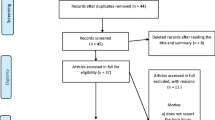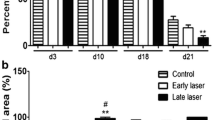Abstract
This systematic review was performed to identify the role of photobiomodulation therapy in experimental models of third-degree burns used to induce oxidative stress. EMBASE, PubMed, and CINAHL databases were searched for studies published between January 2003 and January 2018 on the topics of photobiomodulation therapy and third-degree burns. Any study that assessed the effects of photobiomodulation therapy in animal models of third-degree burns was included in the analysis. A total of 17 studies were selected from 1182 original articles targeted on photobiomodulation therapy and third-degree burns. Two independent raters with a structured tool for rating the research quality critically assessed the articles. Although the small number of studies limits the conclusions, the current literature research indicates that photobiomodulation therapy can be an effective short-term approach to accelerate the healing process of third-degree burns, to increase and modulate the inflammatory process, to accelerate the proliferation of fibroblasts, and to enhance the quality of the collagen network. However, differences still exist in the terminology used to describe the parameters and the dose of photobiomodulation therapy.




Similar content being viewed by others
References
Wang Y, Beekman J, Hew J, Jackson S, Issler-Fisher AC, Parungao R, Lajevardi SS, Li Z, Maitz PKM (2017) Burn injury: challenges and advances in burn wound healing, infection, pain and scarring. Adv Drug Deliv Rev. https://doi.org/10.1016/j.addr.2017.09.018
Ye H, De S (2017) Thermal injury of skin and subcutaneous tissues: a review of experimental approaches and numerical models. Burns 43(5):909–932. https://doi.org/10.1016/j.burns.2016.11.014
Porumb V, Trandabăț AF, Terinte C, Căruntu ID, Porumb-Andrese E, Dimofte MG, Pieptu D (2017) Design and testing of an experimental steam-induced burn model in rats. Biomed Res Int 2017:9878109. https://doi.org/10.1155/2017/9878109
Gomes MT, Campos GRS, Piccolo N, França CM, Guedes GH, Lopes F, Belotto RA, Pavani C, de Lima R d N, da Silva D d FT (2017) Experimental burns: comparison between silver sulfadiazine and photobiomodulation. Rev Assoc Méd Bras 63(1):29–34. https://doi.org/10.1590/1806-9282.63.01.29
Fiório FB, Dos Santos SA, de Melo Rambo CS, Dalbosco CG, Serra AJ, de Melo BL, Leal-Junior ECP, de Carvalho PTC (2017) Photobiomodulation therapy action in wound repair skin induced in aged rats old: time course of biomarkers inflammatory and repair. Lasers Med Sci 32:1769–1782. https://doi.org/10.1007/s10103-017-2254-2
Avci P, Gupta A, Sadasivam M, Vecchio D, Pam Z, Pam N, Hamblin MR (2013) Low-level laser (light) therapy (LLLT) in skin: stimulating, healing, restoring. Semin Cutan Med Surg 32:41–52
Bayat M, Vasheghani MM, Razavi N, Taheri S, Rakhshan M (2005) Effect of low-level laser therapy on the healing of second-degree burns in rats: a histological and microbiological study. J Photochem Photobiol B 78:171–177. https://doi.org/10.1016/j.jphotobiol.2004.08.012
Vasheghani MM, Bayat M, Rezaei F, Bayat A, Karimipour M (2008) Effect of low-level laser therapy on mast cells in second-degree burns in rats
Hooijmans CR, Rovers MM, de Vries RB, Leenaars M, Ritskes-Hoitinga M, Langendam MW (2014) SYRCLE's risk of bias tool for animal studies. BMC Med Res Methodol 14:43. https://doi.org/10.1186/1471-2288-14-43
Brassolatti P, Bossini PS, Oliveira MC, Kido HW, Tim CR, Almeida-Lopes L, De Avó LR, Araújo-Moreira FM, Parizotto NA (2016) Comparative effects of two different doses of low-level laser therapy on wound healing third-degree burns in rats. Microsc Res Tech 79:313–320. https://doi.org/10.1002/jemt.22632
Trajano ET, Mencalha AL, Monte-Alto-Costa A, Pôrto LC, de Souza da Fonseca A (2014) Expression of DNA repair genes in burned skin exposed to low-level red laser. Lasers Med Sci 29:1953–1957. https://doi.org/10.1007/s10103-014-1612-6
Fiório FB, Albertini R, Leal-Junior EC, de Carvalho P de TC (2014) Effect of low-level laser therapy on types I and III collagen and inflammatory cells in rats with induced third-degree burns. Lasers Med Sci 29:313–319. https://doi.org/10.1007/s10103-013-1341-2
Fiório FB, Silveira L Jr, Munin E, de Lima CJ, Fernandes KP, Mesquita-Ferrari RA, de Carvalho P de T, Lopes-Martins RA, Aimbire F, de Carvalho RA (2011) Effect of incoherent LED radiation on third-degree burning wounds in rats. J Cosmet Laser Ther 13:315–322. https://doi.org/10.3109/14764172.2011.630082
Núñez SC, França CM, Silva DF, Nogueira GE, Prates RA, Ribeiro MS (2013) The influence of red laser irradiation timeline on burn healing in rats. Lasers Med Sci 28:633–641. https://doi.org/10.1007/s10103-012-1105-4
de Moraes JM, Eterno de Oliveira Mendonça D, Moura VB, Oliveira MA, Afonso CL, Vinaud MC, Bachion MM, de Souza Lino R Jr (2013) Anti-inflammatory effect of low-intensity laser on the healing of third-degree burn wounds in rats. Lasers Med Sci 28:1169–7116. https://doi.org/10.1007/s10103-012-1213-1
Khoshvaghti A, Zibamanzarmofrad M, Bayat M (2011) Effect of low-level treatment with an 80-Hz pulsed infrared diode laser on mast-cell numbersand degranulation in a rat model of third-degree burn. Photomed Laser Surg 29:597–604. https://doi.org/10.1089/pho.2010.2783
Garcia VG, de Lima MA, Okamoto T, Milanezi LA, Júnior EC, Fernandes LA, de Almeida JM, Theodoro LH (2010) Effect of photodynamic therapy on the healing of cutaneous third-degree-burn: histological study in rats. Lasers Med Sci 25:221–228. https://doi.org/10.1007/s10103-009-0694-z
Meirelles GC, Santos JN, Chagas PO, Moura AP, Pinheiro AL (2008) A comparative study of the effects of laser photobiomodulation on the healing of third-degree burns: a histological study in rats. Photomed Laser Surg 26:159–166. https://doi.org/10.1089/pho.2007.2052
Meireles GC, Santos JN, Chagas PO, Moura AP, Pinheiro AL (2008) Effectiveness of laser photobiomodulation at 660 or 780 nanometers on the repair of third-degree burns in diabetic rats. Photomed Laser Surg 26:47–54. https://doi.org/10.1089/pho.2007.2051
Bayat M, Vasheghani MM, Razavie N, Jalili MR (2008) Effects of low-level laser therapy on mast cell number and degranulation in third-degree burns of rats. J Rehabil Res Dev 45:931–938. https://doi.org/10.1682/JRRD.2007.07.0110
da Silva D de F, Vidal B de C, Zezell DM, Zorn TM, Núñez SC, Ribeiro MS (2006) Collagen birefringence in skin repair in response to red polarized-laser therapy. J Biomed Opt 11(2):024002
Catão MH, Costa RO, Nonaka CF, Junior RL, Costa IR (2016) Green LED light has anti-inflammatory effects on burns in rats. Burns 42(2):392–396. https://doi.org/10.1016/j.burns.2015.07.003
Neves SM, Nicolau RA, Filho AL, Mendes LM, Veloso AM (2014) Digital photogrammetry and histomorphometric assessment of the effect of non-coherent light (light-emitting diode) therapy (λ640 ± 20 nm) on the repair of third-degree burns in rats. Lasers Med Sci 29(1):203–212. https://doi.org/10.1007/s10103-013-1312-7
Oliveira PC, Pinheiro AL, Reis Junior JA, de Castro IC, Gurgel C, Noia MP, Meireles GC, Cangussu MC, Ramalho LM (2010) Polarized light (λ400-2000 nm) on third-degree burns in diabetic rats: immunohistochemical study. Photomed Laser Surg 28(5):613–619. https://doi.org/10.1089/pho.2009.2675
Oliveira PC, Pinheiro AL, de Castro IC, Reis JA Jr, Noia MP, Gurgel C, Teixeira Cangussú MC, Pedreira Ramalho LM (2011) Evaluation of the effects of polarized light (λ400-200 nm) on the healing of third-degree burns in induced diabetic and nondiabetic rats. Photomed Laser Surg 29(9):619–625. https://doi.org/10.1089/pho.2010.2914
Enwemeka CS, Parker JC, Dowdy DS, Harkness EE, Harkness LE, Woodruff LD (2004) The efficacy of low-power lasers in tissue repair and pain control: a meta-analysis study. Photomed Laser Surg 22:323–329. https://doi.org/10.1089/pho.2004.22.323
Toussaint J, Singer AJ (2014) The evaluation and management of thermal injuries: 2014 update. Clin Exp Emerg Med 1:8–18. https://doi.org/10.15441/ceem.14.029
Guo HF, Ali RM, Hamid RA, Zaini AA, Khaza’ai H (2017) A new model for studying deep partial-thickness burns in rats. Int J Burns Trauma 7:107–114
Venter NG, Monte-Alto-Costa A, Marques RG (2015) A new model for the standardization of experimental burn wounds. Burns 41:542–547. https://doi.org/10.1016/j.burns.2014.08.002
Hamblin MR (2017) Mechanisms and applications of the anti-inflammatory effects of photobiomodulation. AIMS Biophysics 4:337–361. https://doi.org/10.3934/biophy.2017.3.337
Rocha JCT, Ferraresi C, Hamblin MR, Damasceno FM, do Nascimento NRF, Driusso P, Parizotto NA (2016) Low-level laser therapy (904 nm) can increase collagen and reduce oxidative and nitrosative stress in diabetic wounded mouse skin. J Photochem Photobiol B 164:96–102. https://doi.org/10.1016/j.jphotobiol.2016.09.017
Oliveira Silva AA, Leal-Junior EC, D'Avila KL, Serra AJ, Albertini R, França CM, Nishida JA, de Carvalho P de TC (2015) Pre-exercise low-level laser therapy improves performance and levels of oxidative stress markers in mdx mice subjected to muscle fatigue by high-intensity exercise. Lasers Med Sci 30:1719–1727. https://doi.org/10.1007/s10103-015-1777-7
Dos Santos SA, Serra AJ, Stancker TG, Simões MCB, dos Santos Vieira MA, Leal-Junior EC, Prokic M, Vasconsuelo A, Santos SS, de Carvalho P de TC (2017) Effects of photobiomodulation therapy on oxidative stress in muscle injury animal models: a systematic review. Oxid Med Cell Longev. https://doi.org/10.1155/2017/5273403
Martins F, Rennó ACM, de Oliveira F, Minatel NP, Bortolin JA, Quintana HT, Aveiro MC (2015) Low-level laser therapy modulates musculoskeletal loss in a skin burn model in rats. Acta Cir Bras 30:94–99. https://doi.org/10.1590/S0102-86502015002000002
Bjordal JM, Lopes-Martins RA, Joensen J, Couppe C, Ljunggren AE, Stergioulas A, Johnson MI (2008) A systematic review with procedural assessments and meta-analysis of low level laser therapy in lateral elbow tendinopathy (tennis elbow). BMC Musculoskelet Disord 9:75. https://doi.org/10.1186/1471-2474-9-75
Khatib MN, Shankar A, Kirubakaran R, Agho K, Simkhada P, Gaidhane S, Zahiruddin SQ (2015) Effect of ghrelin on mortality and cardiovascular outcomes in experimental rat and mice models of heart failure: a systematic review and meta-analysis. PLoS One 10(5):e0126697. https://doi.org/10.1371/journal.pone.0126697
De Vries RBM, Wever KE, Avey MT, Stephens ML, Sena ES, Leenaars M (2014) The usefulness of systematic reviews of animal experiments for the Design of Preclinical and Clinical Studies. ILAR J 55(3):427–437. https://doi.org/10.1093/ilar/ilu043
Funding
This work was supported by grants from the São Paulo Research Foundation (FAPESP, grant number (2015/13677-4) and the National Council for Scientific and Technological (grant number 309065/2015-1).
Author information
Authors and Affiliations
Corresponding author
Ethics declarations
Conflict of interest
The authors declare that they have no conflict of interest.
Rights and permissions
About this article
Cite this article
Ocon, C.A., dos Santos, S.A., Caires, J.R. et al. Effects and parameters of the photobiomodulation in experimental models of third-degree burn: systematic review. Lasers Med Sci 34, 637–648 (2019). https://doi.org/10.1007/s10103-018-2633-3
Received:
Accepted:
Published:
Issue Date:
DOI: https://doi.org/10.1007/s10103-018-2633-3




